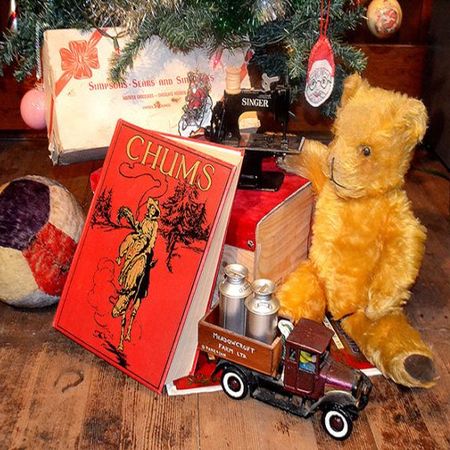
 604 465 4322
604 465 4322General Store Site 12294 Harris Road Pitt Meadows, B.C.
Click Here for Directions& Visiting Hours

Looking Back: Christmas in a small rural town
Looking Back Article from December 2013.
What would a child in Pitt Meadows, back in December 1913, have dreamed of for Christmas?
One thing is certain, unlike their parents, they were not dreaming of becoming a newly incorporated municipality. Just like today, they wanted toys and sweets and time off school.
In reality, in a small, farming community that was living through a world economic depression, most were probably getting a bit of clothing, some fresh fruit and candy and a small toy or book. But these children had access to catalogues from Woodward’s, Eaton’s and Sears Roebuck, and they could dream.
The luckiest of children might hope to receive a “Magic Lantern.” Designed as early slide projectors, these devices used a small oil lamp or candle to project an image from a slide onto a wall, and for children, the content was often cartoons or fairy tales, such as Cinderella.
These slides were sold separately in boxes of up to 10 strips, which could be pulled slowly by the lantern’s light source to show a story. But with a price of up to $7 per unit and $0.25 or more for a box of slides, this toy was not under the tree for most children.
That year was also the time of the Children’s Annual, another popular Christmas gift.
Published since the early 19th Century, these annuals displayed wonderful artwork on their front covers and their insides provided generations of children with advice, thrills, adventures, games and brain teasers.
Considerably more reasonably priced item than the Magic Lantern, these books were more likely to end up under the tree on Christmas morning.
Often, little girls would receive a working, toy-sized model of items their mother had at her disposal, such as sewing machines, stoves and wash tubs. Boys fared about the same with toy saws, hammers and mechanical tin toys.
As always, children in Pitt Meadows for Christmas 1913 would receive clothing. Socks, mitts, underwear and sleepwear were common, but if a little girl was lucky, a muff and matching hat might be under the tree. Or that special doll, with a rubber one costing less than $0.20, and a 20” walking doll going for more than $4. A carriage to transport it in was as much as $6.
A lucky boy had a plethora to receive, including working model steam engines, quality pop guns or a coaster wagon, depending on the budget of the parents.
And what about that tree?
The Christmas tree tradition had been in Canada since the 1840s and was likely established in this community. But in 1913, while Pitt Meadows had plenty of trees, it lacked electricity. Glass ornaments from Germany could be ordered from a catalogue and candles could be used to light trees. More likely, though, the tree was unlit and was decorated with simple homemade ornaments from paper and wood, with the addition of cookies, candy and items from nature.
Merry Christmas from the staff and volunteers at the Pitt Meadows Museum.
Leslie Norman, Curator at the Pitt Meadows Museum.





